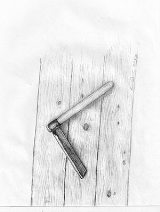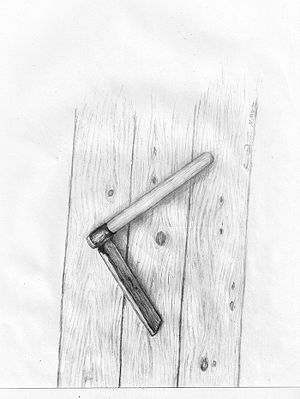
Froe
Encyclopedia

Mallet
A mallet is a kind of hammer, usually of rubber,or sometimes wood smaller than a maul or beetle and usually with a relatively large head.-Tools:Tool mallets come in different types, the most common of which are:...
s to split timber, to make plank
Plank
Plank may refer to:*Plank *Plank , an isometric exercise for the abdominal muscles*The Plank , a British comedy film with no dialogue*The Plank , a remake of the 1967 film...
s, wooden shingles, or kindling
Kindling
Kindling is a term to describe small pieces of wood and twigs used to start a fire.Kindling may also refer to:* Kindling, a 1915 film directed by Cecil B...
; they are safer and more accurate to use than hatchet
Hatchet
A hatchet is a single-handed striking tool with a sharp blade used to cut and split wood...
s because the blade is not swung.
A froe (or frow) is a tool for cleaving wood by splitting it along the grain. It is an L-shaped tool, used by hammering one edge of its blade into the end of a piece of wood in the direction of the grain, then twisting the blade in the wood by rotating the haft (handle). A froe uses the haft as a lever to multiply the force upon the blade, allowing wood to be torn apart with remarkably little force applied to the haft. By twisting one way or the other the direction of the split may be guided.
The origin of the word “froe” is not clear, and some references find it spelled “frow.” One possibility of its roots can be found in the Old English word “fro,” which meant “away,” which was the direction you hammered the “froe” to split the wood.
Froes are similar in general form to axe
Axe
The axe, or ax, is an implement that has been used for millennia to shape, split and cut wood; to harvest timber; as a weapon; and as a ceremonial or heraldic symbol...
s, in that a froe is an L-shaped assembly of a blade head (typically steel) set at a right angle to a handle called a haft (traditionally wood). A froe can be thought of as an axe which is sharpened along the top of a long, narrow, rectangular head, instead of (as the axe is) at the end of a broad curved head. Some froes are made of a single piece of metal with no perpendicular haft. Instead, the handle is the unbeveled end of the blade which extends directly from the blade. These froes must be hammered through the entire piece of wood, as their lack of vertical haft makes it extremely difficult to lever the wood apart.The Woodwright's Guide:Working Wood With Wedge and Edge,section on Froes, Roy Underhill,University of North Carolina, 2008
A given froe can split a piece of wood no wider in its narrowest dimension than the length of the froe's blade; that is, when you place the froe, it must cross the surface of the wood completely.
A froe is also unlike an axe or maul in that the froe can be placed exactly where the user would like the split to begin. With the exception of users with absolute expert aim, axes and mauls cannot. This technique can be used with enough precision that regularity of measurements can be kept when cutting shingles, ground stakes, or even small rails or planks.
Hitting the narrow blade of a froe constantly soon damages a mallet, and so the traditional implement used to hit it is a froe club. This is simply a short length of a thin log, still with the bark on it, with one end reduced with a drawknife
Drawknife
A drawknife is a traditional woodworking hand tool used to shape wood by removing shavings. It consists of a blade with a handle at each end. The blade is much longer than it is deep...
to convenient diameter for a handle. It is rotated slightly in the hand with each blow, so as to even the wear, and although it soon wears out, a new one can easily be made.

